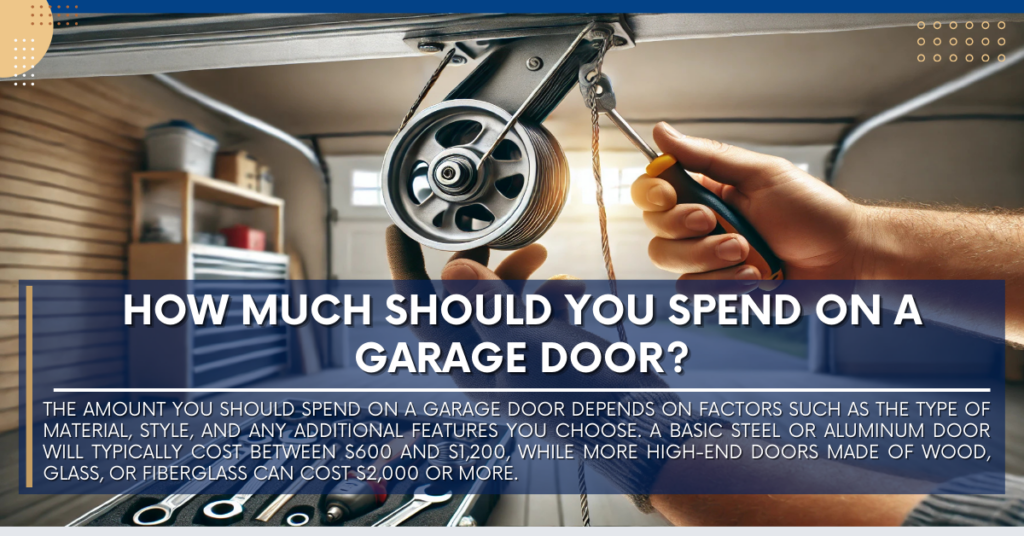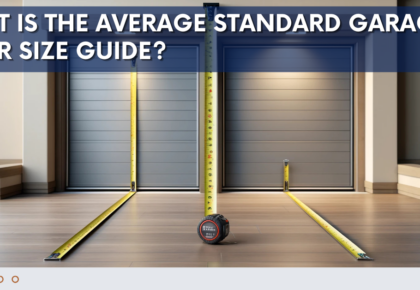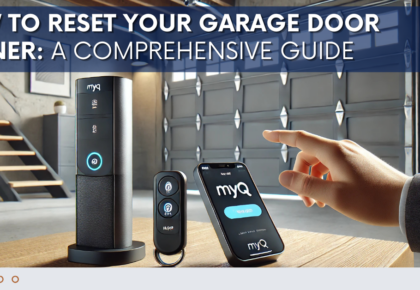Garage doors are an important part of many homes. They provide security, convenience, and even enhance the curb appeal of a property. However, like any mechanical system, garage doors can experience wear and tear, leading to necessary repairs or replacements. Knowing how much it costs to fix a garage door can help you plan your budget and make informed decisions. In this guide, we’ll explore the various aspects of garage door repair costs, including whether DIY repairs are an option, average pricing, and common issues you might encounter.
Can You Fix a Garage Door Yourself?
One of the first things homeowners often wonder when their garage door starts acting up is whether they can fix the issue themselves. While minor problems like lubricating the hinges, tightening screws, or replacing weatherstripping are tasks most homeowners can handle, more complex repairs should be approached with caution. If your garage door opener is malfunctioning, sometimes a simple reset might be all it takes to fix it.
However, more complicated problems—like broken springs, damaged cables, or misaligned rollers—require professional attention. These repairs can be dangerous because garage door springs are under extreme tension. Attempting to fix them without proper tools or knowledge can result in severe injury. Even if you’re comfortable with basic mechanical repairs, it’s safer to leave major issues to professionals who have the right experience.
Tools and Skills Needed for DIY Repairs
If you’re planning to tackle minor repairs on your garage door, having the right tools and skills is crucial. Here are some tools you’ll need for basic repairs:
- Ladder: To reach the higher sections of the door.
- Socket wrench set: Useful for tightening or loosening bolts.
- Pliers: For gripping and adjusting wires or cables.
- Screwdrivers: Both flathead and Phillips for various screw types.
- Lubricant: A silicone-based lubricant to keep the door’s moving parts operating smoothly.
- Replacement parts: Depending on the issue, you might need to buy new springs, rollers, or cables.
Before attempting any repairs, make sure you understand the problem thoroughly. Watching how-to videos or reading repair manuals can help guide you through the process and avoid mistakes that could make things worse.
What Is the Cheapest Way to Replace a Garage Door?
Replacing a garage door can be expensive, but there are ways to keep costs down. One of the most affordable ways to replace a garage door is by opting for a basic, no-frills model made from low-cost materials like steel or aluminum. These doors may not have the high-end look or durability of more expensive options, but they still provide the security and function you need.
You can also save money by purchasing a used or refurbished garage door. Many homeowners sell their old doors when upgrading, and you can often find one in good condition for a fraction of the cost. Just be sure to check the door’s condition thoroughly before buying it and make sure it fits your garage.
DIY Installation: A Budget-Friendly Option
If you’re looking to reduce costs even further, installing the garage door yourself can save you a lot of money. Most garage door manufacturers provide detailed instructions, and many online guides can walk you through the process step-by-step. However, while DIY installation can save you money, it’s a complicated task that requires precision. Misaligning the door or skipping a step could lead to safety risks or costly future repairs. If you’re not confident in your skills, it’s often better to hire a professional installer to avoid potential problems.
How Much Does Lowe’s Charge to Install a Garage Door?
Lowe’s, a popular home improvement store, offers garage door installation services for customers. The cost of having a garage door installed by Lowe’s can vary depending on several factors, such as the size of the door, the material, and any additional features you choose. On average, Lowe’s charges between $300 and $1,500 for installation services, not including the cost of the garage door itself. Prices may also vary depending on whether you need custom installation or additional features like enhanced security.
Breakdown of Installation Costs
Here’s a general breakdown of what you might expect to pay when getting a garage door installed by Lowe’s:
- Standard door installation: $300 – $800
- Custom door installation: $800 – $1,500
- Old door removal: $50 – $150 (if you want the old door taken away)
- Enhanced security features: $100 – $300 for things like reinforced locks or added sensors
It’s always a good idea to request a detailed quote before committing to installation services. You might also find seasonal discounts or special deals that can help reduce the overall cost of installation.
How Much Does It Cost to Replace a Garage Door Pulley?
Garage door pulleys play a key role in allowing the door to open and close smoothly. If a pulley becomes worn out or damaged, it will need to be replaced to maintain the proper function of your garage door. Replacing a garage door pulley typically costs between $50 and $150, depending on the type of pulley and the labor costs in your area. In many cases, replacing a pulley is a straightforward task that a professional can complete in just a few hours.
Signs of a Damaged Pulley
If you’re not sure whether your garage door pulley needs to be replaced, look for these warning signs:
- Strange noises: Grinding, squeaking, or rattling sounds can indicate that the pulley is damaged or worn out.
- Difficulty opening or closing the door: If the door struggles to open or close smoothly, the pulley may need to be replaced.
- Uneven movement: If one side of the door rises or lowers faster than the other, a faulty pulley might be the cause.
Catching and fixing a damaged pulley early on can help prevent more serious and expensive issues later.
Is Replacing a Garage Door Difficult?
Replacing a garage door is not an easy task, especially for those without prior experience in home repairs. The process involves removing the old door, installing the new one, and ensuring that all components—such as the springs, tracks, and cables—are properly aligned and secured. Improper installation can lead to safety risks, as well as poor performance and future damage to the door.
Steps for Replacing a Garage Door
- Prepare the area: Clear away any obstacles and make sure you have plenty of room to work around the garage door.
- Remove the old door: Carefully follow instructions to safely detach the old door from its tracks.
- Install the new door: Follow the manufacturer’s guidelines to ensure the new door is properly installed, with all parts correctly aligned.
- Test the door: Once the installation is complete, check that the door opens and closes smoothly without any issues.
While some homeowners with experience in DIY projects may feel confident enough to tackle the job, most people find it easier and safer to hire a professional installer.
How Much Should You Spend on a Garage Door?

The amount you should spend on a garage door depends on factors such as the type of material, style, and any additional features you choose. A basic steel or aluminum door will typically cost between $600 and $1,200, while more high-end doors made of wood, glass, or fiberglass can cost $2,000 or more.
Factors That Affect Garage Door Prices
- Material: Steel and aluminum doors tend to be the cheapest options. Wood, glass, and fiberglass doors are more expensive but offer better insulation and aesthetic appeal.
- Style: Custom designs, decorative windows, and unique finishes can increase the price.
- Insulation: Insulated doors cost more upfront but can save money on energy bills by keeping your garage better regulated in terms of temperature.
It’s important to find a balance between affordability and quality. While cheaper garage doors may save you money in the short term, investing in a more durable, well-insulated door can save you on energy costs and repairs over time.
What Is the Average Lifespan of a Cheap Garage Door?
A garage door made from low-cost materials, such as thin steel or aluminum, typically lasts around 15 to 20 years. However, factors like weather exposure, frequency of use, and maintenance can affect how long the door lasts. Cheaper garage doors may also require more frequent repairs or replacement of parts, especially if they’re exposed to harsh weather conditions or used heavily.
Tips to Extend the Lifespan of Your Garage Door
- Perform regular maintenance: Check the door regularly for signs of wear and tear. Small issues, such as loose screws or misaligned tracks, can be fixed easily if caught early.
- Lubricate moving parts: Keeping the hinges, springs, and rollers well-lubricated will help prevent damage and ensure smooth operation.
- Protect against weather: Install weatherstripping to keep moisture and drafts out. This will help prevent rust and extend the door’s lifespan.
With proper care, even a budget-friendly garage door can last for many years and provide reliable performance.
Can You Replace One Piece of a Garage Door?
Yes, in many cases, you can replace just one damaged section of a garage door rather than replacing the entire door. This option can save you money, especially if the rest of the door is still in good condition.
Steps for Replacing a Garage Door Panel
- Order the replacement panel: Contact the manufacturer or supplier to get a new panel that matches the existing door.
- Remove the damaged panel: Detach the broken section from the garage door system.
- Install the new panel: Carefully follow the instructions to install the replacement panel and ensure it’s properly aligned with the rest of the door.
Replacement panels usually cost between $250 and $600, depending on the material and design of the door.
How Long Does It Take a Professional to Install a Garage Door?
The time it takes for a professional to install a garage door depends on the size of the door and the complexity of the installation. On average, it takes between 4 to 6 hours to install a new garage door. However, if the installation involves a custom door or if the old door needs to be removed first, the process could take longer.
Factors That Affect Installation Time
- Door size: Larger doors take longer to install.
- Installation complexity: If the door is pre-assembled, it can be installed more quickly than a custom door.
- Old door removal: Removing an old door before installing a new one will add to the time required.
It’s a good idea to discuss the expected installation timeline with your installer in advance so you can plan accordingly.
Garage Door Repair Cost: Broken Spring
One of the most common garage door problems is a broken spring. Garage door springs help lift and lower the door smoothly, but they’re under a lot of tension. When a spring breaks, the door can become very difficult or impossible to open.
Cost of Spring Replacement
Replacing a broken garage door spring typically costs between $150 and $350, depending on the type of spring and labor involved. Extension springs are generally less expensive to replace than torsion springs.
Signs of a Broken Spring
- The door won’t open: A broken spring may leave the door stuck in place.
- Loud noises: A popping or snapping sound when the door operates could indicate a broken spring.
- Uneven movement: If the door moves unevenly or appears unbalanced, a broken spring may be the cause.
Fixing a broken spring promptly is essential to avoid further damage to the garage door system.
Conclusion
Garage door repairs and replacements can vary significantly in cost depending on the type of repair and the materials involved. Simple repairs like lubricating parts or replacing weatherstripping are easy DIY tasks, but more complicated repairs—such as fixing broken springs or installing a new door—are best left to professionals.
By understanding the costs associated with garage door repairs and taking steps to maintain your door regularly, you can avoid unexpected expenses and keep your garage door functioning smoothly for many years. Whether you choose to handle small repairs yourself or hire a professional for more serious issues, keeping your garage door in good working order is a smart investment in your home’s safety and value.








